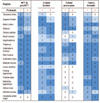Genetic Disorders with Tau Pathology: A Review of the Literature and Report of Two Patients with Tauopathy and Positive Family Histories
- PMID: 26550830
- PMCID: PMC4674317
- DOI: 10.1159/000440840
Genetic Disorders with Tau Pathology: A Review of the Literature and Report of Two Patients with Tauopathy and Positive Family Histories
Abstract
Background: Tauopathies are a group of neurodegenerative disorders characterized by the pathological accumulation of hyperphosphorylated and insoluble tau protein within neurons and glia. Although most cases are sporadic, hereditary tauopathies have also been reported.
Summary: In this article, we review genetic disorders in which tau pathology has been reported and present two novel families with primary tauopathies. Mutations in the microtubule-associated protein tau gene (MAPT) cause a small subset of primary tauopathies. Mutations in 21 other genes and an 18q deletion syndrome have also been reported to be associated with tau pathology reminiscent of Alzheimer's disease, corticobasal degeneration, progressive supranuclear palsy, argyrophilic grain disease or Pick's disease. In 8 of the 21 genes, tau pathology was only seen in cases with some 'specific' mutations. In the remaining genes, tau pathology, often in the form of Alzheimer-type neurofibrillary lesions, was a common finding but was 'not mutation specific'. The probands of the two families were diagnosed with progressive supranuclear palsy based on clinicopathological evaluation. Their family histories were relevant for parkinsonism in 3 siblings of family 1 and 1 brother and the father from family 2, but these were not autopsy-confirmed. DNA from the brains of the probands from these families was screened for MAPT and leucine-rich repeat kinase 2 gene mutations, but no mutations were identified.
Key messages: MAPT mutations are a cause of familial tauopathies, but other genes have also been associated with tau pathology. Novel genes still await discovery.
© 2015 S. Karger AG, Basel.
Figures


References
-
- Lee VM, Goedert M, Trojanowski JQ. Neurodegenerative tauopathies. Annu Rev Neurosci. 2001;24:1121–1159. - PubMed
-
- Revesz T, Holton JL. Anatamopathological spectrum of tauopathies. Mov Disord. 2003;18(Suppl 6):S13–S20. - PubMed
-
- Neve RL, Harris P, Kosik KS, Kurnit DM, Donlon TA. Identification of cdna clones for the human microtubule-associated protein tau and chromosomal localization of the genes for tau and microtubule-associated protein 2. Brain Res. 1986;387:271–280. - PubMed
-
- Cairns NJ, Bigio EH, Mackenzie IR, Neumann M, Lee VM, Hatanpaa KJ, White CL, 3rd, Schneider JA, Grinberg LT, Halliday G, Duyckaerts C, Lowe JS, Holm IE, Tolnay M, Okamoto K, Yokoo H, Murayama S, Woulfe J, Munoz DG, Dickson DW, Ince PG, Trojanowski JQ, Mann DM. Neuropathologic diagnostic and nosologic criteria for frontotemporal lobar degeneration: Consensus of the consortium for frontotemporal lobar degeneration. Acta Neuropathol. 2007;114:5–22. - PMC - PubMed
Publication types
MeSH terms
Grants and funding
LinkOut - more resources
Full Text Sources
Other Literature Sources

